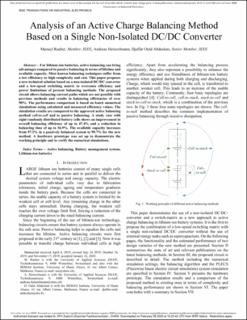Please use this identifier to cite or link to this item:
https://doi.org/10.21256/zhaw-19665Full metadata record
| DC Field | Value | Language |
|---|---|---|
| dc.contributor.author | Räber, Manuel | - |
| dc.contributor.author | Heinzelmann, Andreas | - |
| dc.contributor.author | Ould Abdeslam, Djaffar | - |
| dc.date.accessioned | 2020-03-05T15:01:44Z | - |
| dc.date.available | 2020-03-05T15:01:44Z | - |
| dc.date.issued | 2020 | - |
| dc.identifier.issn | 0278-0046 | de_CH |
| dc.identifier.issn | 1557-9948 | de_CH |
| dc.identifier.uri | https://digitalcollection.zhaw.ch/handle/11475/19665 | - |
| dc.description | © 2020 IEEE. Personal use of this material is permitted. Permission from IEEE must be obtained for all other uses, in any current or future media, including reprinting/republishing this material for advertising or promotional purposes, creating new collective works, for resale or redistribution to servers or lists, or reuse of any copyrighted component of this work in other works. | de_CH |
| dc.description.abstract | For lithium-ion batteries, active balancing can bring advantages compared to passive balancing in terms of lifetime and available capacity. Most known balancing techniques suffer from a low efficiency or high complexity and cost. This paper proposes a new technical solution based on a non-isolated DC/DC converter and a low-speed switching matrix to overcome efficiency and power limitations of present balancing methods. The proposed circuit allows balancing current paths which are not possible with previous methods and results in balancing efficiencies of over 90%. The performance comparison is based on batch numerical simulations using calculated and measured efficiency values. The simulation results are compared to the approved active balancing method cell-to-cell and to passive balancing. A study case with eight randomly distributed battery cells shows an improvement in overall balancing efficiency of up to 47.4% and a reduction in balancing time of up to 36.9%. The available capacity increases from 97.2% in a passively balanced system to 99.7% for the new method. A hardware prototype was set up to demonstrate the working principle and to verify the numerical simulations. | de_CH |
| dc.language.iso | en | de_CH |
| dc.publisher | IEEE | de_CH |
| dc.relation.ispartof | IEEE Transactions on Industrial Electronics | de_CH |
| dc.rights | Licence according to publishing contract | de_CH |
| dc.subject | Active balancing | de_CH |
| dc.subject | Battery management system | de_CH |
| dc.subject | Lithium-ion battery | de_CH |
| dc.subject.ddc | 621.3: Elektro-, Kommunikations-, Steuerungs- und Regelungstechnik | de_CH |
| dc.title | Analysis of an active charge balancing method based on a single non-isolated DC/DC converter | de_CH |
| dc.type | Beitrag in wissenschaftlicher Zeitschrift | de_CH |
| dcterms.type | Text | de_CH |
| zhaw.departement | School of Engineering | de_CH |
| zhaw.organisationalunit | Institut für Energiesysteme und Fluid-Engineering (IEFE) | de_CH |
| dc.identifier.doi | 10.1109/TIE.2020.2972449 | de_CH |
| dc.identifier.doi | 10.21256/zhaw-19665 | - |
| zhaw.funding.eu | No | de_CH |
| zhaw.originated.zhaw | Yes | de_CH |
| zhaw.publication.status | acceptedVersion | de_CH |
| zhaw.publication.review | Peer review (Publikation) | de_CH |
| zhaw.webfeed | Erneuerbare Energien | de_CH |
| zhaw.author.additional | No | de_CH |
| Appears in collections: | Publikationen School of Engineering | |
Files in This Item:
| File | Description | Size | Format | |
|---|---|---|---|---|
| 2020_Raeber-etal_Active-Charge.pdf | Accepted Version | 2.03 MB | Adobe PDF |  View/Open |
Show simple item record
Räber, M., Heinzelmann, A., & Ould Abdeslam, D. (2020). Analysis of an active charge balancing method based on a single non-isolated DC/DC converter. IEEE Transactions on Industrial Electronics. https://doi.org/10.1109/TIE.2020.2972449
Räber, M., Heinzelmann, A. and Ould Abdeslam, D. (2020) ‘Analysis of an active charge balancing method based on a single non-isolated DC/DC converter’, IEEE Transactions on Industrial Electronics [Preprint]. Available at: https://doi.org/10.1109/TIE.2020.2972449.
M. Räber, A. Heinzelmann, and D. Ould Abdeslam, “Analysis of an active charge balancing method based on a single non-isolated DC/DC converter,” IEEE Transactions on Industrial Electronics, 2020, doi: 10.1109/TIE.2020.2972449.
RÄBER, Manuel, Andreas HEINZELMANN und Djaffar OULD ABDESLAM, 2020. Analysis of an active charge balancing method based on a single non-isolated DC/DC converter. IEEE Transactions on Industrial Electronics. 2020. DOI 10.1109/TIE.2020.2972449
Räber, Manuel, Andreas Heinzelmann, and Djaffar Ould Abdeslam. 2020. “Analysis of an Active Charge Balancing Method Based on a Single Non-Isolated DC/DC Converter.” IEEE Transactions on Industrial Electronics. https://doi.org/10.1109/TIE.2020.2972449.
Räber, Manuel, et al. “Analysis of an Active Charge Balancing Method Based on a Single Non-Isolated DC/DC Converter.” IEEE Transactions on Industrial Electronics, 2020, https://doi.org/10.1109/TIE.2020.2972449.
Items in DSpace are protected by copyright, with all rights reserved, unless otherwise indicated.